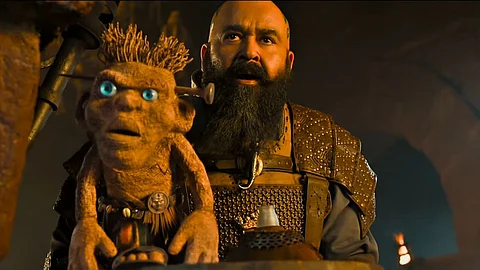

A few minutes into Mohanlal’s directorial debut Barroz, spears and rocks come flying out of the screen—as if the film wants us to consume everything that it throws at us without thinking. Meanwhile, a screw is drilled into a voodoo doll, forced to bear witness to the antics of Vasco Da Gama’s slave ghost played by Mohanlal. It acts like an unintended metaphor—the only way out of this cinematic purgatory is to sit through it.
The next few minutes – that feel like hours – are spent questioning the film’s claim that it is “for children”. The fusion of several genres–stage play, historical drama, fantasy, thriller, musical and even a bizarre animated sequence–is captivating, but the antics shown by the ghost are in no way child-like and leave a bad aftertaste. Barroz is an amalgamation of characters from films of Steven Spielberg and James Cameron, viewed through a romanticised lens of Santhosh Sivan. For a children’s movie, there is overuse of liquor and crass jokes on consumption of liquor. Some conversations are outrightly patronising and you wonder if Mohanlal understands today’s generation.
The plot has the ghost, named Barroz, protecting Da Gama’s treasure trove for around 400 years. The only way to achieve salvation for both him and the doll is to give the keys to the true descendant of the Portuguese conqueror. While it is a pretty straightforward children’s story to tell, the director tries to juxtapose it with a modern-day tale of crony capitalism. Set in Goa, once a Portuguese colony, the personal conflict of the ghost is developed amid protests against casinos in the state. The theme of reincarnation plays a major role, which has been used as a staple for movies of such genre in the past. Barroz realises that he has to hand over the keys to Da Gama’s daughter Isabella, reincarnated as Isa. Her father Ron Madhav (Tuhin Menon), a businessman, wants to build a casino where the treasure is located.
What’s disappointing for a film that had such a powerful premise is that it stereotypes the slaves and protesters, empowering the elite class. Through Ron, Mohanlal uses terms such as ‘anti-social’ to denote the group of protesters and justifies gambling as a method for economic development. The cinematic treatment makes it seem like young girls need to be tamed by elders, giving off a boomer vibe. This downward gaze is amplified through a scene where Isa is asked to apologise to her father, portraying her as a wayward girl who gets enlightened through Barroz.
It is hard to describe performances in a film that seems so artificial. Three actors play the role of Isabella – Maya Rao West, Shayla McCaffrey, and Nerea Camacho – but all of them are forgettable. Joshua Okesalako as Muwesi Maria, an occultist, delivers a fine performance despite the character being poorly written. Bhasi Vaikom’s voice for Voodoo and the screen presence of Rafael Amargo as Da Gama ensures that the fort does not fully crumble. Mohanlal is a shadow of himself that we have already seen in films like Odiyan, Kayamkulam Kochunni and Malaikottai Vaaliban.
What really makes Barroz unique is its stellar use of technology, especially the use of 3D. It is on par with ARM, if not better, in providing a feeling of being there in Mohanlal’s cinematic universe. While Santosh Sivan sticks to his tried and tested template, the music by Lydian Nadhaswaram feels fresh. It would have worked better if it was in the hands of a trained singer than Mohanlal.
Once Mohanlal’s magnum opus ends, all of our life decisions flash before our eyes. There is a cameo that would have ideally set the theatres clapping but the audience were too exhausted to care. The ambition is appreciable, but it felt too forced in a film that came with high expectations. In an interview with Baradwaj Rangan, Mohanlal said that he would not direct another film after this. If that’s the case, “India’s answer to Marlon Brando” would have directed the same number of films as that of the OG.
Disclaimer: This review was not paid for or commissioned by anyone associated with the film. Neither TNM nor any of its reviewers have any sort of business relationship with the film’s producers or any other members of its cast and crew.